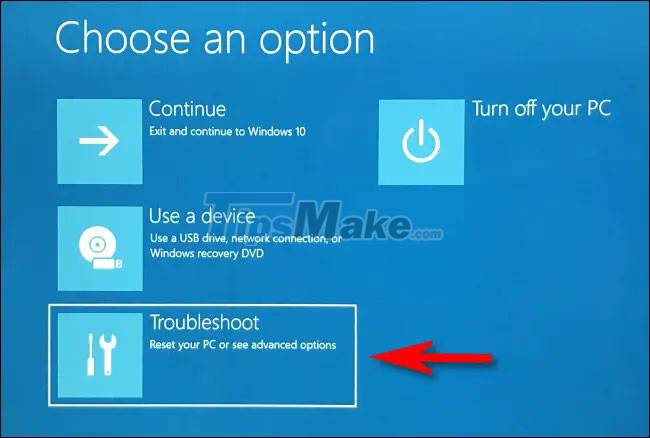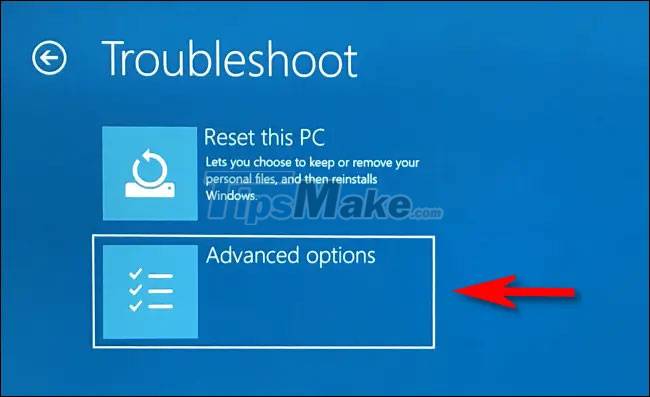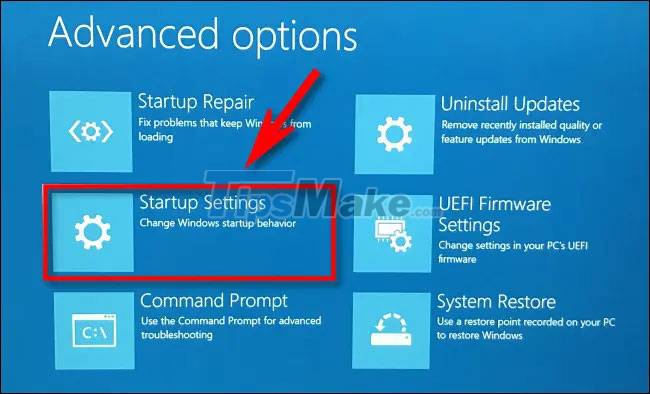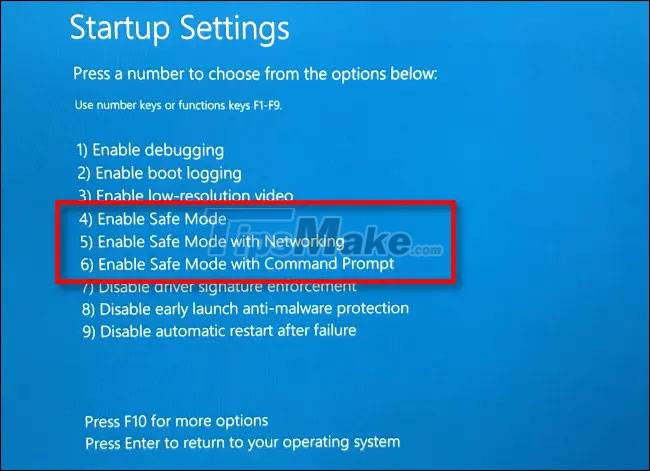How to access Safe Mode on Windows 11
In this mode, drivers and features on the system will be temporarily disabled to help your PC operate more stably. Here's how.+
Access Safe Mode at system startup
For Windows 7 and earlier, users can usually access Safe Mode by pressing a specific function key (such as F8) as soon as the PC is starting up. However, Microsoft removed this feature starting with Windows 8 because thanks to new technologies, Windows PC boot time has now become so fast that users can't even press the function key to access Safe. Mode, Windows has finished downloading.
Instead, Microsoft designed an "automatic failover" solution for cases where the PC crashes and Windows doesn't load properly. Your PC will automatically go into troubleshooting mode if it can't be started twice in a row. You can do this by powering on your PC, then pressing the physical power button as soon as you see the manufacturer's logo appear. Do this twice and you will see the 'Choose an Option' advanced startup screen appear on the screen. Then follow the instructions described in the section below to enter Safe Mode.
How to access Safe Mode Windows 11
There are several different ways for you to start your computer in 'Advanced Startup' mode, thereby accessing 'Safe Mode' on Windows 11.
The simplest way is to open the Start menu and click on the power button icon in the bottom right corner. Then hold down the Shift key on your keyboard and click 'Restart'.

In addition, another 'more cumbersome' way is through the Settings application. First, press the Windows + i key combination to open the Settings application. When the Settings interface opens, click on the 'System' item, then select 'Recovery'.

On the Recovery settings page, find the 'Advanced Startup' option and click the 'Restart Now' button next to it.

Windows will confirm with a pop-up dialog asking you to save your work before restarting. When you're ready, click 'Restart Now'.

Windows will then shut down and restart on a blue screen titled 'Choose an Option', with a few options available. Click on 'Troubleshoot'.

On the Troubleshoot page, click 'Advanced Options'.

On the Advanced Options page, click on 'Startup Settings'.

In Startup Settings, click 'Restart'.

The PC will reboot into the 'Startup Settings' menu with 9 numbered options. Press the '4' key on your keyboard to select Safe Mode, '5' for Safe Mode with Networking or '6' for Safe Mode with Command Prompt.

Once you've made your selections, Windows will reboot into the corresponding mode (Safe Mode). Your screen will be downgraded to a lower resolution and Windows will also replace the desktop background image with a black background that says 'Safe Mode' in the corners.

Now you can perform any troubleshooting task you want. When done, just reboot (or shut down) your Windows 11 PC as usual. If all went well and the problem is fixed, the next time you reboot, you'll be back in regular Windows mode. Good luck!
You should read it
- Start Safe Mode on Windows XP
- Enable, use, and disable Safe Mode in Windows 8
- Enable Safe Mode in Windows 7
- The procedure to open Microsoft Office 2013/2016 in Safe Mode
- How to turn on Safe Mode on Android
- Instructions to bring Safe Mode to the standard Boot Menu on Windows 8 and 10
- Put Safe Mode in the standard boot menu of Windows XP
- How to Start Windows 8 in Safe Mode
May be interested
- How to Enter Safe Mode on Windows 11 Quickly and Easily
 all versions of windows have safe mode, and so does windows 11 insider preview. hacom shows you how to boot into safe mode in windows 11.
all versions of windows have safe mode, and so does windows 11 insider preview. hacom shows you how to boot into safe mode in windows 11. - How to access Recovery Mode (Safe Mode) in Ubuntu
 when problems occur with computer operating systems in general, one of the first solutions to think about is to use recovery mode (safe mode). with ubuntu is no exception.
when problems occur with computer operating systems in general, one of the first solutions to think about is to use recovery mode (safe mode). with ubuntu is no exception. - Put Safe Mode in the standard boot menu of Windows XP
 when you encounter problems with windows xp, you may need to boot the system in safe mode. however, choosing safe mode boot mode is not intuitive and is a user-friendly task.
when you encounter problems with windows xp, you may need to boot the system in safe mode. however, choosing safe mode boot mode is not intuitive and is a user-friendly task. - How to Start Windows 8 in Safe Mode
 safe mode is an advanced troubleshooting mode where windows boots up without third-party software. windows 8 starts up faster than earlier versions of windows and optimizes various setting for touchscreen devices, therefore the procedures...
safe mode is an advanced troubleshooting mode where windows boots up without third-party software. windows 8 starts up faster than earlier versions of windows and optimizes various setting for touchscreen devices, therefore the procedures... - Instructions for setting F8 key to start Windows 8 in Safe Mode
 one of the most common and simple ways to troubleshoot is to boot the computer into safe mode. in previous windows versions (like windows 7, vista ...) you can easily boot your computer in safe mode by pressing f8 during the boot process.
one of the most common and simple ways to troubleshoot is to boot the computer into safe mode. in previous windows versions (like windows 7, vista ...) you can easily boot your computer in safe mode by pressing f8 during the boot process. - How to boot into Safe Mode on Mac
 if your mac is having difficulty starting or you are experiencing startup problems, you should start your mac in safe mode to try to identify and resolve the problem. we'll show you how to do it.
if your mac is having difficulty starting or you are experiencing startup problems, you should start your mac in safe mode to try to identify and resolve the problem. we'll show you how to do it. - How to enter Safe Mode on Windows 7
 how to enter safe mode on windows 7. safe mode is a great rescue mode when the computer encounters emergencies but not to the point of having to use the backup system partition or have to reinstall the entire system. here tipsmake.com will postpone
how to enter safe mode on windows 7. safe mode is a great rescue mode when the computer encounters emergencies but not to the point of having to use the backup system partition or have to reinstall the entire system. here tipsmake.com will postpone - What is Safe Mode? When to use Safe Mode
 if you have been using windows operating system, at least you have heard about safe mode. but do you know anything about safe mode? what it is used for and how it works on windows.
if you have been using windows operating system, at least you have heard about safe mode. but do you know anything about safe mode? what it is used for and how it works on windows. - Quick fix computer error Windows 10/8/7 crashes, Safe Mode can not be escaped
 usually we start our computer in safe mode to fix errors. however in some cases you sometimes start your computer in safe mode and the computer hangs. so how to fix the error in this case, please refer to the following article of network administrator.
usually we start our computer in safe mode to fix errors. however in some cases you sometimes start your computer in safe mode and the computer hangs. so how to fix the error in this case, please refer to the following article of network administrator. - How to enter Safe Mode on Windows 10
 how to enter safe mode on windows 10. safe mode is the mode that helps windows start up with minimal equipment and services, which can diagnose where windows is corrupted and fix it.
how to enter safe mode on windows 10. safe mode is the mode that helps windows start up with minimal equipment and services, which can diagnose where windows is corrupted and fix it.










 How to disable audio devices on Windows 11
How to disable audio devices on Windows 11 PowerToys is now available in Windows 11 Microsoft Store
PowerToys is now available in Windows 11 Microsoft Store How to use Night Light in Windows 11
How to use Night Light in Windows 11 Virtual machines without TPM 2.0 are prohibited from installing Windows 11 Insider Preview
Virtual machines without TPM 2.0 are prohibited from installing Windows 11 Insider Preview How to change the mouse pointer size and style in Windows 11
How to change the mouse pointer size and style in Windows 11 Microsoft released a new Tips application for Windows 11, with more than 100 tips for using the operating system
Microsoft released a new Tips application for Windows 11, with more than 100 tips for using the operating system